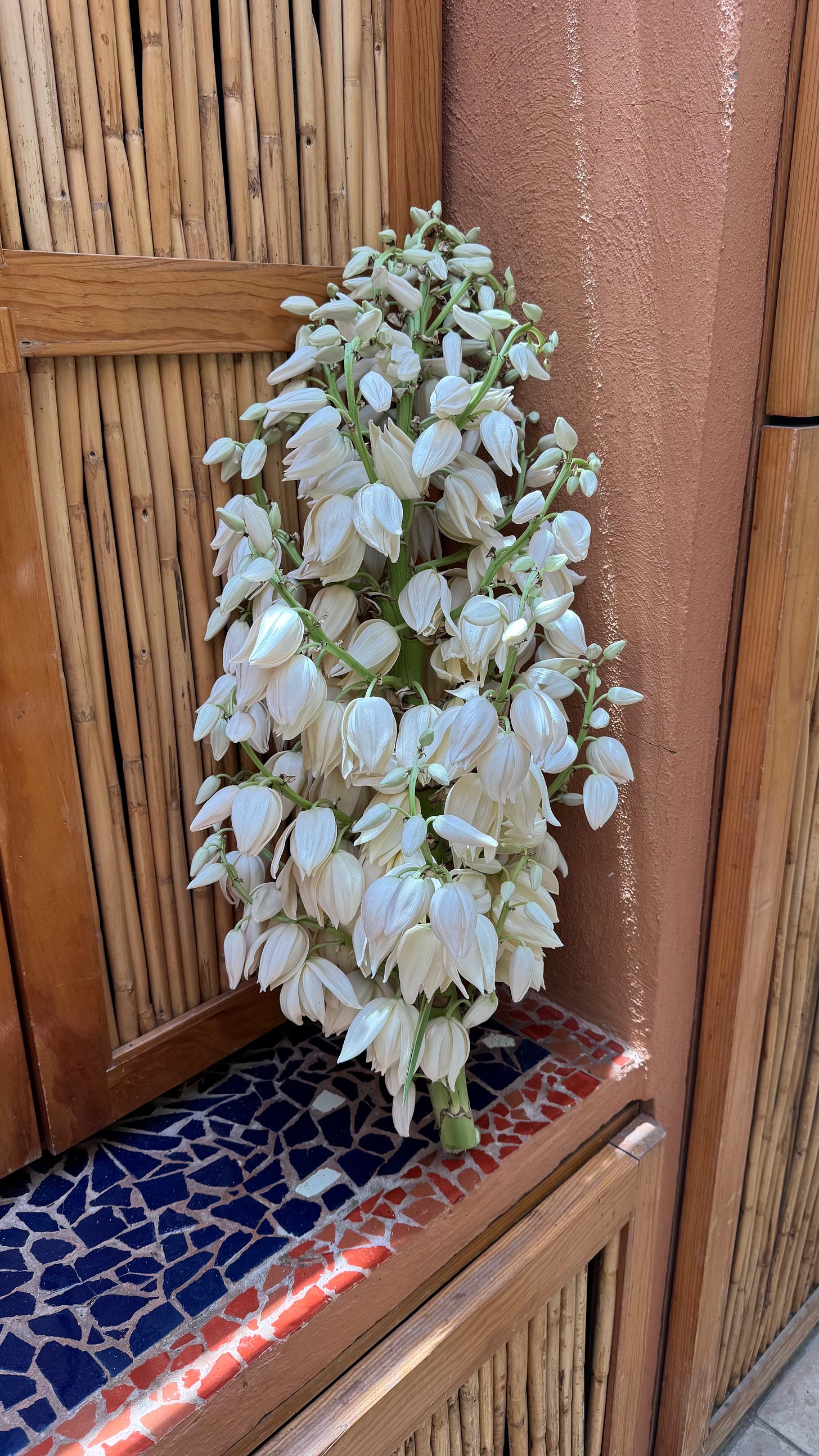Lessons Learned Foraging for Flor de Izote
An edible flower growing in Mexico helps me learn about our home environment.
The thing about moving is that after a while, you begin to get clued into the small things you first missed. That type of observation is vitally important both for daily life and everyday comfort and for foraging, the act of going out into the wild (or even just your backyard) and looking for uncultivated but delicious things you can eat. An experience foraging in upstate New York was so magical that it made me want to live in a place that was closer to nature, and foraging has helped make life here feel a little more normal. In a lot of ways, foraging requires mindfulness, and when you pay close attention to minute details, things begin to slide into focus, and your life becomes calmer and more contained. In these terrible times, my focal points increasingly come from the natural world, and one of the most surprisingly profound in my life resulted from a cooking request from Edgar.
One day, only a few weeks after we moved into our house in Mexico, Edgar came to me and pointed to a cluster of flowers growing from the top of a tall, thin plant with spiky, sword-like leaves. “Did you know those flowers are edible?” he asked.
I did not, and I looked up at the plant curiously. It was about fifteen feet tall and crowned by a tall, narrow stalk from which multiple rows of flowers with big, white, fleshy petals were emerging. The plant was a yucca, and the flowers are often called flor de izote. While a huge number of flowers all across the world are edible, it never would have occurred to me that those particular flowers, at the top of a plant that looked extremely not-delicious, would be a delicacy worthy of chopping down. But then again, virtually everything I’d learned about foraging no longer applied because my limited understanding of the natural world had been fairly shattered by our move.
While Oaxaca is home to the familiar sights of pine and oak, and our grassy medians, riverbanks, and fields might host dandelions, sunflowers, and wild garlic, we traded the concrete of New York and the temperate forests of the state for high desert at an elevation more than five thousand feet higher than where we had been before. I’d gained nature but at the expense of my understanding of it, our lives transported into a land of thorns and rocks. Whatever precious gems of information I’d managed to horde were, in an instant, largely useless. Everything I’d learned about foraging no longer applied.
When Edgar pointed out to me that a plant growing on our actual property was edible, I was thrilled, and I think my desire to try cooking it became a bit of a bonding experience for us. Edgar had been trying for years to convince Victor, one of the previous owners of our house, to cut down the flowers, but Victor liked the flowers and neither he nor his wife, Penny, was probably all that interested in trying to turn them into something edible. I, on the other hand, was more than happy to indulge his request, and Edgar stuck a ladder against the side of the plant and climbed up with a handsaw. Soon, a gigantic branch of flowers lay on our kitchen island.
Since those first weeks, we’ve had multiple additional harvests, and I’ve learned a lot about the flowers Edgar asked me to cook. I’ve learned that after the yucca plant flowers, it begins to die, and that you can encourage it to keep growing by chopping off the top of the plant, an act that will spur it to branch. I’ve learned that flor de izote taste a bit like artichokes but are exceptionally bitter, and that when you boil them a dirty grey and bitter scum rises to the top of the water that needs to be skimmed off. Edgar taught me that a classic pairing for the blanched flowers are scrambled eggs, sliced onions, fresh chiles like jalapeño, and garlic, all of which is then eaten with tortillas, but trial and error taught me that for the absolute best texture you have to cook the eggs separately and then gently fold the curds into the cooked vegetables. I also learned that tiny brown ants love to drink the nectar in the center of the flower, and that unless you want a bit of extra protein in your food, you need to wash the petals thoroughly.
More than anything, though, the flor de izote has taught me that we don’t even have to leave our property to find wild things we can eat, and that knowledge has led me on a much closer examination of our immediate environment. On our property, I’ve found wild greens, and Edgar pointed out we have bananas growing, and the flor de izote made me look more closely at the road leading to our house. I’ve found wood ear mushrooms growing on the trunk of a tree, a towering Mexican mulberry tree, two varieties of avocados, orange loquats, gigantic grapefruit, thin firetruck red chiles, tiny and bitter wild tomatoes, and a type of green banana-like Mexican fruit called a guajilote.
The flor de izote, though, will always be a special flavor for us, and now I track when the yucca plants on our property are starting to blossom and plan our lunches around the anticipated arrival of the blooms. So when Edgar triumphantly announced two days ago that another plant had blossomed, I told him to go get his saw.




Oh those tiny little ants can find their way! I also unknowingly ate some in Costa Rica until I got wiser to the things around us. I also now know that although mustard greens look a lot like spinach, oops they’re not. My morning smoothie with bitter mustard greens was ick! The wonders of learning about new things in your new home!
How satisfying to forage your own food. Your scramble with the flowers sounds good!